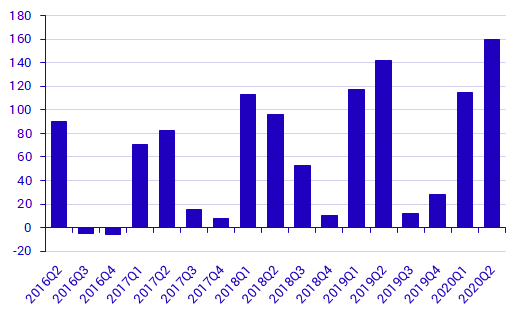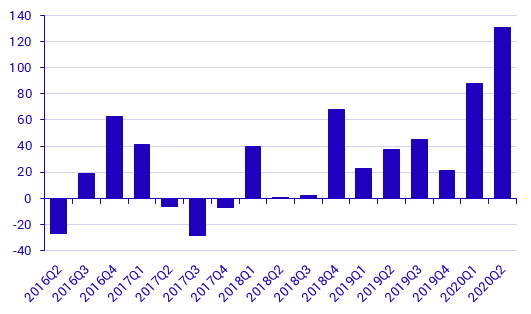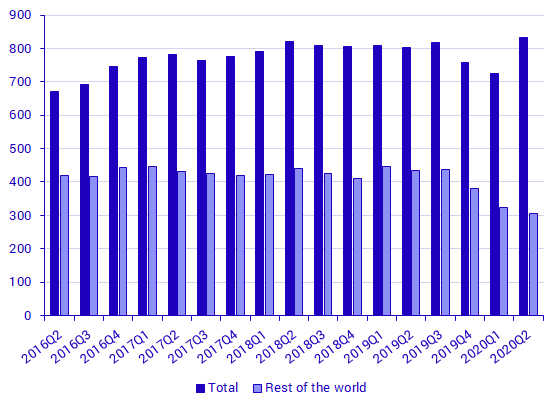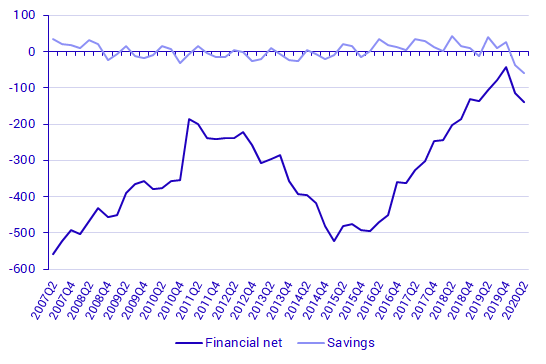Financial accounts second quarter 2020
Households’ savings amounted to SEK 160 billion
Statistical news from Statistics Sweden and Swedish Financial Supervisory Authority 2020-09-22 9.30
The economic effects of the coronavirus pandemic were reflected clearly in the Financial Accounts for the second quarter of 2020. Households’ financial savings amounted to SEK 160 billion, which is the highest level since the start of the time series. Financial savings for non-financial corporations were also high for a second quarter, while central government financial savings were heavily negative.
Households’ financial savings amounted to SEK 160 billion in the second quarter of 2020. The main contributors to the high level of savings were net deposits in bank accounts and net purchases of listed shares, which amounted to SEK 73 billion and SEK 15 billion respectively.

High level of financial savings for non-financial corporations
Non-financial corporations’ financial savings amounted to SEK -9 billion. Despite the negative savings level, it was uncommonly high for a second quarter. One explanation for the high level of savings was that non-financial corporations chose to refrain from or postpone dividends, which otherwise commonly occur in the second quarter. Non-financial corporations placed savings mainly in bank accounts, in which net deposits amounted to SEK 131 billion, the highest recorded level in a single quarter.

Riksbank continued to purchase mortgage bonds
To further support the financial market during the coronavirus pandemic, the Riksbank continued net purchases of mortgage bonds totalling SEK 88 billion in the second quarter of 2020. The Riksbank’s holdings in mortgage bonds amounted to SEK 98 billion at the end of the quarter. In addition to mortgage bonds, to provide support the Riksbank also made net purchases of commercial papers totalling SEK 5 billion.
The Riksbank also continued making net purchases of government bonds valued at SEK 23 billion during the period. Holdings in government bonds amounted to SEK 408 billion at the end of the quarter. At the same time, the Riksbank’s holdings in debt securities increased by SEK 109 billion, and holdings in foreign debt securities decreased by SEK 19 billion in the second quarter of 2020. The decrease in value was mainly due to a stronger Swedish krona.

Negative financial savings for central government
Central government financial savings were negative in the second quarter of 2020 and amounted to SEK -59 billion, following negative financial savings of SEK -37 billion in the first quarter of 2020.
Central government debt amounted to SEK 2 134 billion at the end of the second quarter of 2020. In the first six months of 2020, central government debt increased by SEK 138 billion. Central government financial net wealth has increased steadily in the past five years, but has decreased in the past two quarters.

Revisions
In connection with the calculation of the second quarter 2020, yearly and quarterly statistics have been revised for the years 1996-2019. Retained dividends, seen as a transaction under European ESA 2010 regulations, have been revised for some sectors and introduced for the first time for other sectors. This adjustment affects transactions in investment funds and indirectly also in other instruments, such as premium pensions for households. This revision was introduced as from 2010 for holdings in foreign-registered funds, and as from 2017, for holdings in Swedish-registered funds. Furthermore, the rest of the world sector was revised as from the first quarter 2018 with new information from the Balance of Payments. Several revisions have also been made with regard to public administration. A review was carried out of bond repurchases (premiums and discounts) for the period 2014 and forward. This review affects transactions and revaluations, but not balance in bonds. Tax accrual has been updated as from 2012, while other revisions are mainly from 2018 and forward.
Definitions and explanations
The financial accounts aim to provide information about financial assets and liabilities, and about changes in financial savings and financial wealth in different economic sectors.
Financial savings, net lending/net borrowing, in the Financial Accounts is calculated as the difference between transactions in financial assets and transactions in liabilities. Net lending/net borrowing is measured as the difference between income and costs in the non-financial sector accounts, which, like the Financial Accounts, form part of the National Accounts. However, financial accounts and non-financial sector accounts are based on different sources, which gives rise to differences.
In the Financial accounts, the national debt calculation is different from the measure of national debt most often reported, which is calculated based on the convergence criteria, also known as the Maastricht debt. The Maastricht debt does not comprise all financial instruments; the instruments are reported at nominal value, and the central government debt is consolidated. In the Financial accounts, the national debt is unconsolidated and includes all financial instruments at market value.
In addition to government agencies, the central government sector also includes certain government foundations and some State-owned enterprises. Central government does not include units in the old-age pension system. Instead, they comprise of the sector social security funds. Local government includes primary municipal authorities, regional authorities (formerly county council authorities), municipal associations, some municipal foundations, and some local government-owned enterprises.
Further information: The National Wealth
The National Wealth, which contains annual data on non-financial and financial assets, is also published in connection with the publication of the Financial Accounts. Financial assets and liabilities are collected from Financial accounts and are thereby consistent with the values published in Financial Accounts.
For further information, see:
Nationalförmögenheten och nationella balansräkningar (in Swedish) (pdf)
Next publishing will be
The next statistical news in this series is scheduled for publication on 2020-12-17 at 09:30.
Statistical Database
More information is available in the Statistical Database
Feel free to use the facts from this statistical news but remember to state Source: Statistics Sweden.
